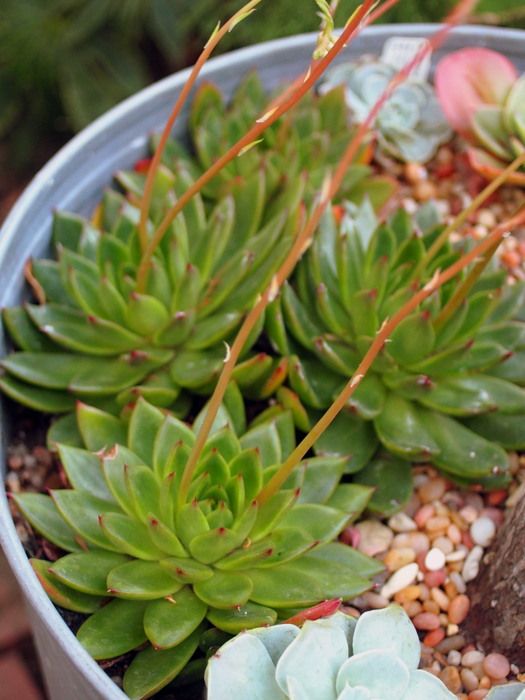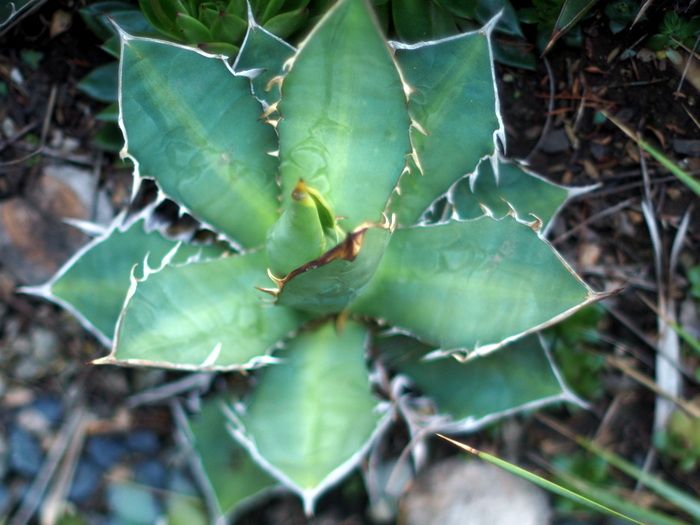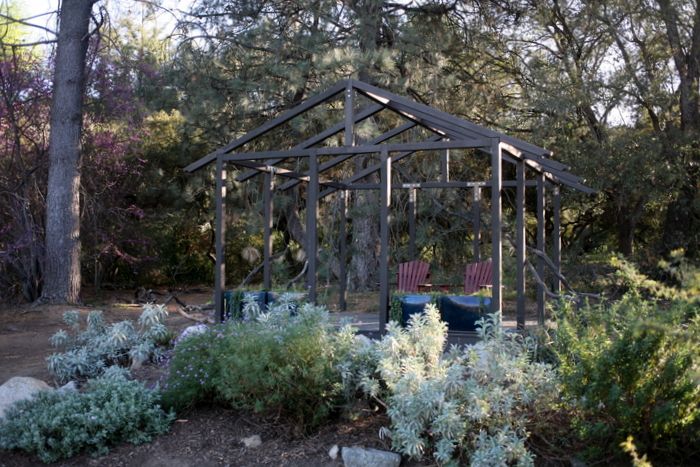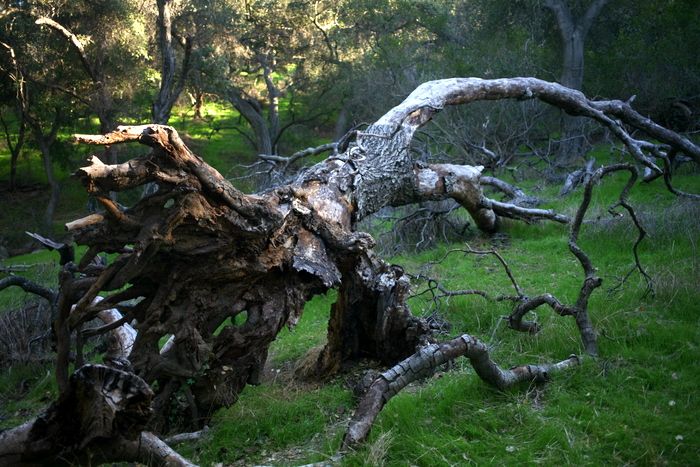I was determined to attend botanist Jeff Chemnick‘s talk on plant exploration in Oaxaca, Mexico, yesterday, 7 p.m., hosted by SoCal Hort, located in an auditorium within spitting distance of Griffith Park. I had just visited his home garden/nursery in an October trip to Santa Barbara and very much wanted to know more about his plant-exploring Mexico Nature Tours.

My domesticated Echeveria agavoides will have to do as a stand-in for those depicted in the wild. Jeff’s slide show of previous tours was a who’s who of the leading lights of horticulture, all having what looked like the time of their lives: Carol Bornstein, Bart O’Brien, Randy Baldwin, Greg Starr, Brian Kemble (leading a pack mule). With 30 years of experience exploring Mexico, it looks like you couldn’t find a better tour guide than Jeff, one who knows where to find the often dwindling colonies of astrophytum, mammillaria, echeveria, agave, dioon, furcraea, ferocactus, fouquieria, pseudobombax, etc, etc. Don’t miss his talk if you get the chance.

Also not in habitat but my front garden, Agave titanota ‘Lanky Wanky,’ a selection by Kelly Griffin, another attendee of Jeff’s tours. Titanota shows incredible variability in the wild, which Jeff says sparks vociferous debate among tour-goers, much to his amusement. Jeff is more of a cycad guy, yet finds his group’s varying enthusiasms irresistible, whether it’s orchids, tree dahlias, bromeliads, birds — his knowledge on all that and more is encyclopedic.
As always, driving to the foothills from Long Beach for an evening lecture requires careful strategizing. Even though only 30 miles north, leaving after 4 p.m. from Long Beach would be an insane, gridlocked commute, so I was on the road by 1 p.m. Of course, I would stop by Potted, just down the street on Los Feliz, and then figure out what to do with the remaining four or five hours once I was there. Mary and Annette were in full bustling mode, making Potted even more gorgeous than the last time I visited, which seems impossible and yet they keep doing it over and over. Their experience with plays and film really comes through in staging the shop. Mary helpfully suggested a visit to Descanso Gardens, about 20 minutes away, to kill some hours before the talk. It sounded like a sensible, if not exactly thrilling plan. Frankly, I’ve always had a bit of a bias against Descanso, associating them with predictable displays of dwarf annuals in summer and then their infamous camellia garden extravaganza for winter. You know, that boring public garden stuff. And these strong opinions were formed by….not a single visit. I’ve never visited Descanso, ever. (Though I did write a brief post citing a news article about it here.) And apparently Descanso has changed quite a bit in the decades I’ve been clinging to those strong, untested opinions.

Okay, so I was wrong. Very wrong. I wasn’t expecting simple rusticity with Salvia apiana and Verbena lilacina.

But it’s not all my fault. I just wasn’t paying attention as Descanso slowly turned the ship around on a mission to save what oaks they could and replant an oak woodland, even if it meant disappointing some of the camellia lovers.

Expecting tidy floral displays, instead I found this. Acres of woodland to explore. After years of clearing out eucalyptus and other exotics, in 2014 five acres of oak woodland were opened to the public.

“Can I walk to the nursery and buy a new camellia? Yes I can,” Sullivan said. “Can I run down to Armstrong and purchase that oak tree? Probably not. This is a naturally occurring oak forest.” — Brian Sullivan — “A Change of Plans at Descanso Gardens”
Brian Sullivan left Descanso in 2013 and is now Vice President for Landscape, Gardens, and Outdoor Collections at New York Botanical Garden. He started at Descanso as an untrained gardener.
And not to worry, there are still dozens of camellias just about to burst into full bloom, and a rose garden, a Japanese garden, a new entrance garden almost completed, restoration of historic buildings, and the gift shop had a nifty selection of plants. (Thanks for the well-grown Plectranthus argentatus.) But that oak woodland is really something, a place you’ll want to take your kids and grandkids to for years to come.
So it turned out to be a fine day for a lecture and some unexpected nature touring very close to home.
More on the woodland restoration from “Planting and Protecting California Oaks“:
“In a presentation on the history of Descanso Gardens, Brian Sullivan, director of horticulture and operations, referenced the evolving mission of Descanso. Originally developed as a camellia farm for the cut flower industry, owner Manchester Boddy bought two entire camellia nurseries in 1942, Star and San Gabriel, before the owners were sent to Manzanar. Boddy planted 50,000 camellias over 19 acres under the mature oaks.
When the gardens were transferred to a public botanic garden in 1953, maintenance of the camellias continued to include hand watering each plant. In the 1980s oscillating sprinklers were installed for efficient overhead watering.
In the 1990s the Descanso Guild, nonprofit overseers who manage this L.A. County Parks Department property, began to review the foundation of the garden: the California oaks. The conditions so favorable to camellias, including shade, leaf-enriched soil, and overhead summer watering, were detrimental to the oak overstory. In nature, the oaks would be re-seeding and replacing themselves. The density of the camellia plantings edged out new oaks and curbed the camellias. Planted so closely, these C. japonicas were unusually tall and gangly, with sparse blooms.
A long-range study was conducted last year to review and revise the garden’s maintenance, with an eye to the future health of the camellias and oaks. The resulting plan is being enacted, concurrent with growth and dormancy cycles. The camellias are being pruned, which will force prolific flowers. And the camellias will be gently “teased apart” from the oaks and re-established in a separate 10-acre “estate garden,” complete with micro-spray irrigation. The oaks will slowly return to the cyclic rains of Southern California’s Mediterranean climate with cool, wet winters and hot, dry summers.”

That’s wonderful news about the oaks at Descanso.
I wonder if the Boddy descendants even acknowledge their exploitative part in the horror of Japanese internment (for which non-Japanese growers lobbied hard and from which many profited). They owe apologies and reparations.
My, my! Things HAVE changed. I don’t think I’ve been there in at least 15 years. I, too, thought of it as primarily a place to display Camellias. Now, I’ll have to put it on my list to visit.
Well I must admit I somehow held the same bias. I’ve had many opportunities to visit Descanso but never thought it worth my time. Good to know I was wrong!
@Nell, so chilling to read that in a short sentence. 20k and a formal apology came from the feds in the ’80s — not sure about individual apologies.
@Kris, wait for spring. Lots of building going on now and areas cordoned off.
@Loree, next time you visit Potted, it’s a short trip away. At the very least there are some long walks that crunch and smell like a woodland.
They had a rose garden I seem to recall, and because I was in the throes of my rose collecting obsession in the late 70’s I would visit there -as I recall. It made absolutely no impression on me and I have not been back. There are people who are quite devoted to Camellias (I’m not one of them) and Descanso used to be a bit of a Mecca for them.
Have not been there for several years. The oaks are really special, and the history of the place, and how Boddy worked to preserve it as a garden not a housing development.
The traffic is just ridiculous–can’t get anywhere anymore, it seems. What happens as So Cal adds another 10 million humans?
Same bias here. That’s why I didn’t visit in December. But thanks to your post, I’ll add Descanso to my list for my next trip. Oak woodlands are becoming ever more special since they’re disappearing so quickly elsewhere.